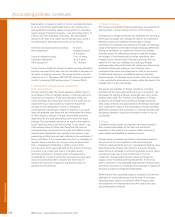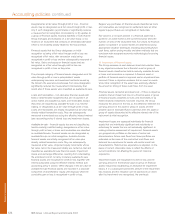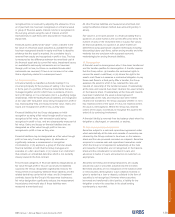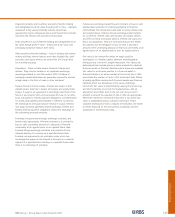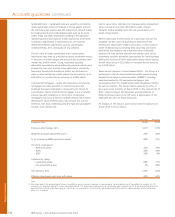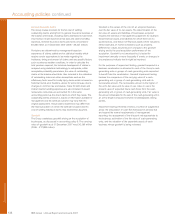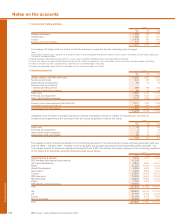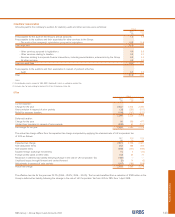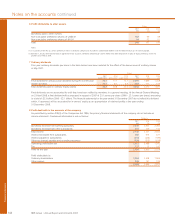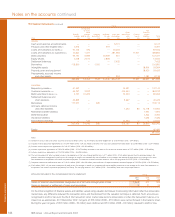RBS 2007 Annual Report Download - page 138
Download and view the complete annual report
Please find page 138 of the 2007 RBS annual report below. You can navigate through the pages in the report by either clicking on the pages listed below, or by using the keyword search tool below to find specific information within the annual report.
RBS Group • Annual Report and Accounts 2007
136
Accounting policies continued
Financial statements
Syndicated loans – syndicated loans are valued by considering
recent syndication prices in the same or similar assets, prices in
the secondary loan market, and with reference to relevant indices
for credit products and credit default swaps such as the LevX,
LCDX, ITraxx and CDX. Assumptions relating to the expected
refinancing period are based on market experience and market
convention. Adjustments to observed prices are made for
differences between instruments, such as counterparty
creditworthiness, term, and quality of any collateral.
The fair value of drawn syndicated loans valued using
techniques other than by considering recent syndication prices
in the same or similar assets and prices in the secondary loan
market was £4,624 million. Using reasonably possible
alternative assumptions about refinancing periods (which were
stressed by one year) and the value attributed to potentially
favourable flexible loan conditions (which are attributed no
value in reported figures) would reduce the fair value by up to
£46 million or increase the fair value by up to £83 million.
Commercial mortgages – senior and mezzanine commercial
mortgages are loans secured on commercial land and
buildings that were originated or acquired by the Group for
securitisation. Senior commercial mortgages carry a variable
interest rate and mezzanine or more junior commercial
mortgages may carry a fixed or variable interest rate. Factors
affecting the value of these loans may include, but are not
limited to, loan type, underlying property type and geographic
location, loan interest rate,
loan to value ratios, debt service coverage ratios, prepayment
rates, cumulative loan loss information, yields, investor
demand, market volatility since the last securitisation, and
credit enhancement.
Where observable market prices for a particular loan are not
available, the fair value will typically be determined with
reference to observable market transactions in other loans or
credit related products including debt securities and credit
derivatives. Assumptions are made about the relationship
between the loan and the available benchmark data. Using
reasonably possible alternative assumptions for credit spreads
(taking into account all other applicable factors) would reduce
the fair value by up to £52 million or increase the fair value by
up to £49 million.
Super senior tranches of asset-backed CDOs – the Group is a
participant in the US asset-backed securities market: buying
residential mortgage-backed securities (‘RMBS’), including
securities backed by US sub-prime mortgages, and
repackaging them into collateralised debt obligations (‘CDOs’)
for sale to investors. The Group retains exposure to some of
the super senior tranches of these CDOs. In the second half of
2007, rising mortgage delinquencies and expectations of
declining house prices in the US led to a deterioration of the
estimated fair value of these exposures.
An analysis of the Group’s super senior tranche exposures to
these CDOs is shown below:
High grade Mezzanine
Exposure (£m) 6,420 3,040
Exposure after hedges (£m) 3,073 1,790
Weighted average attachment point (1) 29% 46%
% of underlying RMBS sub-prime assets 69% 91%
Of which originated in:
– 2005 and earlier 24% 23%
– 2006 28% 69%
– 2007 48% 8%
Collateral by rating:
– investment grade 98% 31%
– non-investment grade 2% 69%
Net exposure (£m) 2,581 1,253
Effective attachment point post write down 40% 62%
Note:
(1) Attachment point is the minimum level of losses in a portfolio to which a tranche is exposed, as a percentage of the total notional size of the portfolio. For example, a 5-10%
tranche has an attachment point of 5% and a detachment point of 10%. When the accumulated loss of the reference pool is no more than 5% of the total initial notional of the
pool, the tranche will not be affected. However, when the loss has exceeded 5%, any further loss will be deducted from the tranche’s notional principal until the detachment
point, 10%, is reached.


